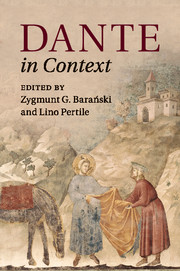Book contents
- Frontmatter
- Dedication
- Contents
- List of illustrations
- List of maps
- Notes on contributors
- Chronology
- Abbreviations and note on translations
- Introduction
- Part I Politics and society
- 1 Empire, Italy, and Florence
- 2 Economy
- 3 Law
- 4 Justice
- 5 Men and women
- 6 Church and orthodoxy
- 7 Heresy and dissidence
- 8 Daily life
- Part II Intellectual traditions
- Part III Linguistic and literary cultures
- Part IV Visual and performative culture
- Part V Dante: life, works, and reception
- Further reading
- Index
1 - Empire, Italy, and Florence
from Part I - Politics and society
Published online by Cambridge University Press: 05 October 2015
- Frontmatter
- Dedication
- Contents
- List of illustrations
- List of maps
- Notes on contributors
- Chronology
- Abbreviations and note on translations
- Introduction
- Part I Politics and society
- 1 Empire, Italy, and Florence
- 2 Economy
- 3 Law
- 4 Justice
- 5 Men and women
- 6 Church and orthodoxy
- 7 Heresy and dissidence
- 8 Daily life
- Part II Intellectual traditions
- Part III Linguistic and literary cultures
- Part IV Visual and performative culture
- Part V Dante: life, works, and reception
- Further reading
- Index
Summary
In June 1273 Pope Gregory X (1210–76) travelled to Florence to make peace between the Guelf and Ghibellines factions. The reconciliation took place in a public ceremony near the Rubaconte bridge (now Ponte alle Grazie) before a crowd of notables that included Charles of Anjou (1226–85), ruler of Naples and vicar of Tuscany, and Baldwin of Flanders (1217–73), the deposed Latin ruler of Constantinople. Gregory went next to Lyons, where at an ecumenical church council (1274) he confirmed the election of Rudolf of Habsburg (1218–91) as Holy Roman Emperor and arranged religious peace with Byzantium and its emperor Michael Palaeologus (1223–82), who had retaken Constantinople in 1261. The act united the Greek and Roman Churches.
In quick succession, Gregory appeared to solve many of the most divisive issues of the day. Contemporary Italian writers expressed great hope at the turn of events. The Dominican chronicler Salimbene de Adam of Parma (1221–c.1288) credited Gregory with ‘renewing the empire’ and praised him as ‘just, generous and saintly’. The Roman chronicler Saba Malaspina spoke of the start of a ‘golden age’ that would bring peace and prosperity to Italy, especially to the troubled Regno (Kingdom) and the south. Dante's thoughts, however, are unknown. Gregory X and his deeds at Florence and Lyons do not appear in the poet's work. Gregory's efforts, if indeed truly realistic, came to little. He had hardly left Florence when the factions repudiated their accord and began quarrelling anew. Rudolf of Habsburg became mired in intramural battles in the north against a rival claimant, Otto II (c.1230–78), King of Bohemia, and failed to take up his Italian inheritance and the imperial crown, which remained vacant until the advent of Henry VII of Luxembourg (c.1275–1313) in Italy forty years later (1310). Charles of Anjou and Michael Palaeologus launched mutual attacks against each other in Albania and Epirus, and Anjou's own authority in southern Italy was soon undermined by revolt in Sicily (1282). Meanwhile, Palaeologus' religious accommodation at Lyons was repudiated at home, and when he died in 1282 he was denied Christian burial by angry Greek prelates.
Italy remained ‘a ship without a pilot in a great storm’ (Purg. VI, 76–7). Dante's adulthood and political career coincided with what historians view as a high point in civic discord and upheaval.
- Type
- Chapter
- Information
- Dante in Context , pp. 9 - 29Publisher: Cambridge University PressPrint publication year: 2015



